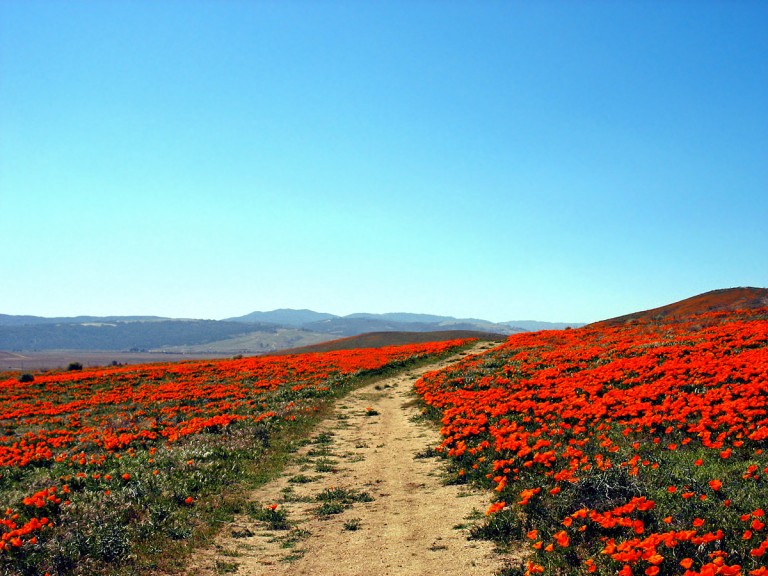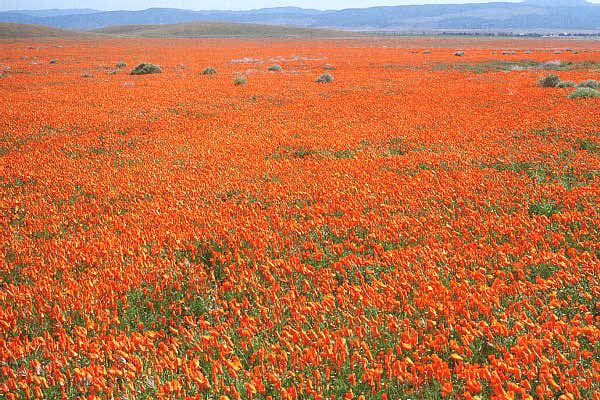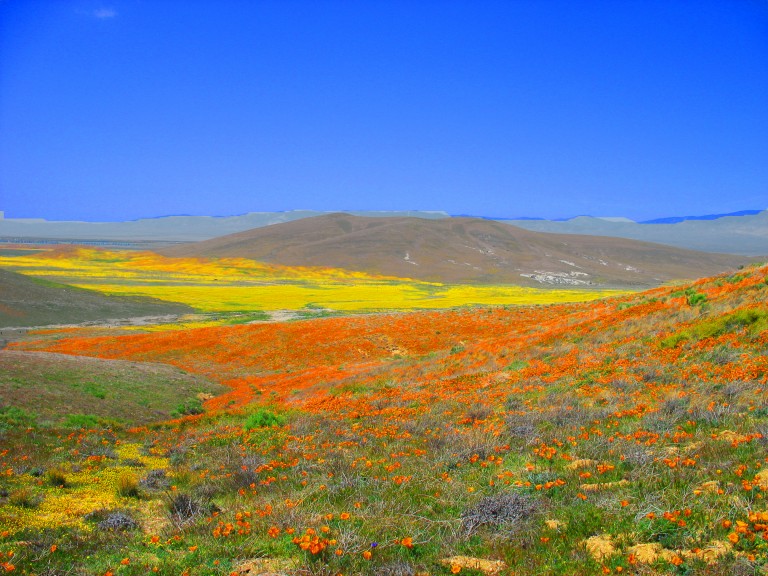GOLDEN CREAM
Antelope Valley, CA– I had to leave New York for a second so I went to California.
A friend in LA said, “I think the poppies are going off.”
So I took a numbered road out of the city.
Hills draped with a bright orange carpet of flowers laced with purple and yellow. Thin dirt trail necklaces. A preserve for escholtiza californica. Golden poppies.
“…a burning color–not orange, not gold, but if pure gold were liquid and could raise a cream, that golden cream might be like the color of the poppies.” –John Steinbeck, East of Eden
The California Poppy Reserve is a real thing. A state sanctioned thing. A gesture of confidence. Of pride. An elegant undertaking.
The Reserve lives in the Antelope Valley in Southern California. On the western edge of the Mojave desert. One hour and a half northeast of Los Angeles. It’s hills covered with flowers. And sometimes it’s not. All depends on how much it rained that winter. When there is little rain, there are few flowers. When there is a lot of rain there are a lot of flowers. This year there was a lot of rain.
“Wooooooooow.” “Click. Click. Click. Click. Click.” “Jesus these flowers are just breathtaking!” Korean pop music seeping out of an old man’s transistor radio. “Whoah.”
It’s quiet too. There are shaded benches where one can sit, eat a sandwich, sip water, write notes like these or just stop and smell the flowers.
Native American’s called them fire flowers and thought they were sent to drive away the frost and famine.
The Spanish called them ‘cop de or’ (cup of gold.) Some forty-niners thought gold formed where poppy petals fell to the ground. They would press them in letters they sent back East. This year the poppies bloomed on hundreds of instagram feeds and people in certain parts of the world touched pictures of them with their thumbs.
Attraction. Golden poppies don’t happen to be beautiful. They are beautiful so they can be. They attract insects who move from flower to flower transferring pollen from male to female. A flier at the preserve’s visitor center explains that the shape of California Poppies makes them easier to fertilize than other flowers. Even stumbling beetles can make a go of it. California poppies are easy.
A flower preserve. A shriek of color in the dun colored desert. A good idea arising from the humdrum. It can make the floor of the desert the sky for a while. Like the debris of a sunset shattered by clouds.
Jane Pinheiro loved desert plants. Her watercolor paintings of desert flowers are so accurate they are used in textbooks. She was a self-taught artist born in 1907. She died in 1978. Jane created eight wildflower and wildlife sanctuaries. She also created an art gallery, a museum, and a Unitarian church. She loved the desert. The interpretive center at the poppy reserve is named after her. She and her husband never earned over eight thousand dollars a year.
A faded slideshow plays at the interpretive center. A narrator talks about flowers and the desert. It feels like a substitute teacher day in grade school. The best part is the music. Twelve string folk guitar strumming far better than it needs to be. Who commissioned the song? Where did they find the musician? Did he see the flowers first? How much was he paid? Did the money go directly to beer and back rent? What a project California was. Is?
The poppy has friends. Silver lupine streak the hills. Phacelia, chia. desert dandelions. Scent of sage comes in on the wind.
Flowers happened without humans. They grouped together and figured out how to survive.
Humans found pleasure in the flowers. They grouped together to help themselves flourish. They grouped together and helped the flowers survive. Most are happy they did.
California is experiencing a drought. Or rather, there are drought conditions in California, but it’s unclear that people are “experiencing” them. Perhaps the people can learn from the seeds of desert wildflowers. Hold fast. Bide your time. And when (if) water returns, blossom colorful, bright, stunning.


